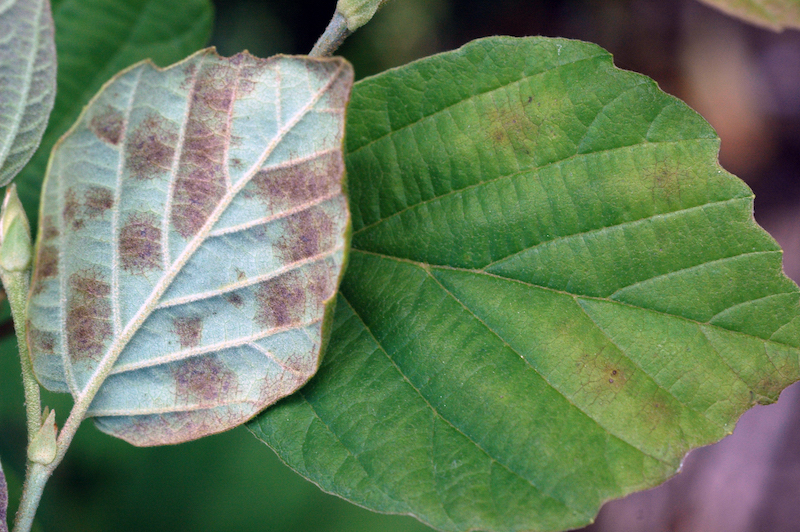Fothergilla are easy-to-grow shrubs popular for their year-round interest and versatility in the landscape. As members of the witch hazel family, very few diseases impact fothergilla. These shrubs are most commonly impacted by leaf spot, a fungal disease, and chlorosis, a physiological condition. Prolonged occurrences of either of these disorders can lead to weakened, stunted plants with a slower rate of growth. With quick identification and treatment, you can grow robust, healthy fothergilla.

Leaf Spot
Leaf spot is a disease of fothergilla caused by the fungal pathogen Pseudocercospora. As the name implies, leaf spot causes unsightly, necrotic spots on the plant’s leaves. In severe cases, early defoliation may occur. Symptoms usually appear in summer. The spores of this pathogen are spread by both water and wind. Fothergilla plants grown in full sun or in extremely wet conditions are more susceptible to leaf spot. Pseudocercospora leaf spot is rarely fatal for fothergilla, but infections can weaken the plant, especially if re-infection occurs.
Identifying Leaf Spot
Pseudocercospora leaf spot looks like brown, irregularly shaped splotches along the surface of the leaves. The spots may be outlined with yellow tissue. The splotches can cover the entire surface of the leaves in severe infections, and subsequent leaf drop may occur.

Image by Jay W. Pscheidt, Oregon State University 2012
Treating Leaf Spot
Prune out any branches affected by Pseudocercospora leaf spot. Rake and destroy leaves from infected plants to lessen the chance of re-infection. Since leaf spot spores can spread by water, consider using a soaker hose or a drip irrigation system to water your fothergilla. These systems apply water directly to the roots without getting the foliage wet, therefore reducing a way for this disease to spread. Fungicides labeled for use on Pseudocercospora can be applied per label instructions as a preventative measure. Multiple applications may be needed.
Chlorosis
Chlorosis is a term for the yellowing of leaves in plants. This is a physiological condition that can have many causes. In fothergilla, chlorosis is mainly caused by growing this shrub in soils that are too alkaline. Fothergilla needs to grow in acidic soils with a pH of 5-6.5. In alkaline soils, essential nutrients such as iron, zinc, and manganese may be tied to the soil. Since pH affects the bioavailability of plant nutrients, chlorosis may occur as the plants are unable to properly uptake nutrients. This affects the plant’s ability to produce sufficient chlorophyll, which gives plants their green color.
Identifying Chlorosis
Chlorosis appears as yellowed leaves often accompanied by slowed or stunted growth. Sometimes the chlorosis may be interveinal, meaning that the veins of the leaves are darker green while the surrounding tissue is light green or yellow. In severe cases, leaves may turn brown and dieback can occur.
Treating Chlorosis
Take a soil test from your local extension office to determine if the soil pH is the cause of the chlorosis. Consider sending in a separate sample of the plant tissue to identify any nutrient deficiencies. Amend the soil with pH-reducing products such as aluminum sulfate as needed. If the chlorosis does not improve after acidifying the soil, apply a slow-release fertilizer formulated for acidic-loving plants in the spring.
Fothergilla Disease Chart
|
Disease |
Identifying |
Treating |
|
Leaf Spot |
Brown splotches on leaves, defoliation |
Prune/discard branches, remove fallen leaves, reduce overhead watering, fungicides |
|
Chlorosis |
Yellow leaves, green veins, stunted growth, dieback |
Reduce soil pH and use acid-loving fertilizer |
Sources: "Fothergilla." Clemson University, Clemson Cooperative Extension. hgic.clemson.edu
 |
Lauren Youngcourt - Published 06-17-2023 |
